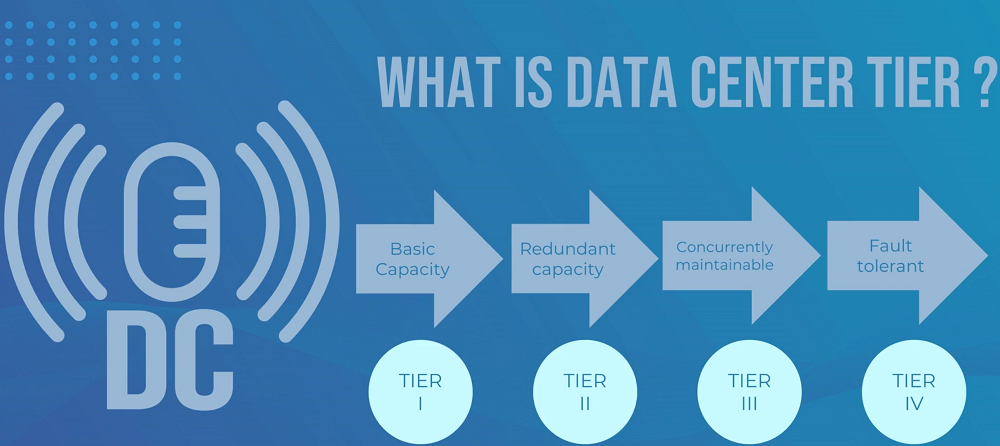NEWS TAG
brand
Tier 1 vs Tier 2 vs Tier 3 vs Tier 4 Data Center: Difference Between Tier 1/2/3/4 Data Center
Data centers are the backbone of modern IT infrastructure, housing critical systems and resources for businesses across the globe. However, not all data centers are created equal. To classify their capabilities, the Uptime Institute developed a tier system that categorizes data centers into four levels: Tier 1, Tier 2, Tier 3, and Tier 4. Each tier represents a level of performance, reliability, and redundancy. In this blog, we’ll break down the differences between these tiers to help you understand which type of data center suits your needs.

What is a Data Center Tier?
Data center tiers are an international standard for classifying data centers based on their resiliency and performance capabilities. This system, created by the Uptime Institute, serves as a guideline for organizations to choose data centers that align with their operational and business requirements.
The tiers range from Tier 1 (Basic Capacity) to Tier 4 (Fault Tolerance), with higher tiers offering better performance, availability, and redundancy. Let’s explore each tier in detail.
Tier 1 Data Center: Basic Capacity
Tier 1 data centers are the most basic type of data center. They provide essential infrastructure for IT operations but lack redundancy. Here are the key characteristics:
Single path for power and cooling.
Includes basic components such as:
- An Uninterruptible Power Supply (UPS) to handle brief power outages, sags, and spikes.
- Dedicated cooling equipment that operates 24/7.
- An engine generator to manage extended power outages.
Susceptible to single points of failure.
Suitable for small businesses with limited budgets and minimal uptime requirements.
Availability: 99.671% uptime, or approximately 28.8 hours of downtime per year.
Tier 2 Data Center: Redundant Capacity
Tier 2 data centers build on Tier 1 by adding redundant components for increased reliability. These facilities include:
Redundant power and cooling components, such as:
Extra UPS modules.
Backup chillers, pumps, and generators.
Redundancy allows for select maintenance opportunities, reducing the risk of disruptions from equipment failures.
However, downtime is still possible during component failures or maintenance.
Availability: 99.741% uptime, or approximately 22 hours of downtime per year.
Tier 3 Data Center: Concurrently Maintainable
Tier 3 data centers are designed for concurrent maintainability, meaning that maintenance activities can occur without disrupting IT operations. Key features include:
Multiple power and cooling paths, ensuring one path remains operational during maintenance.
Full redundancy of critical components.
No need for shutdowns during equipment replacement or maintenance.
This tier is ideal for businesses with high uptime requirements, such as financial institutions or large enterprises.
Availability: 99.982% uptime, or approximately 1.6 hours of downtime per year.
Tier 4 Data Center: Fault Tolerance
Tier 4 data centers are the highest-performing and most resilient facilities. They are designed to handle both planned maintenance and unplanned events without any impact on IT operations. Key features include:
Multiple active power and cooling paths, with redundancy in each path.
Complete fault tolerance, ensuring uninterrupted service even during component failures or power disruptions.
Extremely rare outages, making them the best choice for mission-critical applications.
Availability: 99.995% uptime, or approximately 26.3 minutes of downtime per year.
Tier 1 vs Tier 2 vs Tier 3 vs Tier 4 Data Center: What are the Differences?
The key differences between the tiers lie in their redundancy, resiliency, and availability guarantees. Here’s a quick comparison:
| Feature | Tier 1 | Tier 2 | Tier 3 | Tier 4 |
|---|---|---|---|---|
| Infrastructure | Basic | Redundant Components | Concurrently Maintainable | Fault Tolerant |
| Redundancy | None | Partial | Full | Fully Fault Tolerant |
| Power and Cooling Paths | Single | Single with Redundancy | Multiple | Multiple Active Paths |
| Maintenance Impact | Requires Downtime | Some Downtime Possible | No Downtime for Maintenance | No Downtime for Maintenance or Failures |
| Fault Tolerance | None | Limited | Moderate | High |
| Uptime Guarantee | 99.671% (28.8 hours/year) | 99.741% (22 hours/year) | 99.982% (1.6 hours/year) | 99.995% (26.3 minutes/year) |
| Use Case | Small businesses with low budgets | Medium-sized businesses with moderate needs | Large enterprises with critical systems | Mission-critical operations like healthcare or global e-commerce |
Tier 1 vs Tier 2 vs Tier 3 vs Tier 4 Data Center, Which One Is Better For Your Business?
Selecting the right tier depends on your organization's requirements, budget, and tolerance for downtime. For example:
Tier 1: Suitable for small businesses with limited IT needs and budgets.
Tier 2: A step up for businesses requiring some redundancy but still accepting occasional downtime.
Tier 3: Ideal for enterprises needing high availability and concurrent maintainability.
Tier 4: Best for mission-critical operations where downtime is not an option, such as healthcare or global e-commerce platforms.
Data Center Standards and Best Practices
While the Uptime Institute’s tier system provides an international standard, there are additional guidelines and standards to consider:
ANSI/TIA-942: Developed by the American National Standards Institute, this standard complements the Uptime Institute’s classifications by incorporating architectural and telecommunications requirements.
Best Practices: Just as you would hire an architect to design your home, businesses often consult experts to ensure their data centers meet industry standards and align with their goals.
Understanding the differences between Tier 1, Tier 2, Tier 3, and Tier 4 data centers is crucial for making informed business decisions. While Tier 1 and Tier 2 are cost-effective for smaller businesses, Tier 3 and Tier 4 provide the reliability and resilience required by larger organizations and critical industries. Ultimately, the choice of data center tier will depend on your budget, business needs, and uptime requirements. By aligning your IT strategy with the right data center tier, you can ensure your organization’s operations remain efficient, secure, and uninterrupted.
